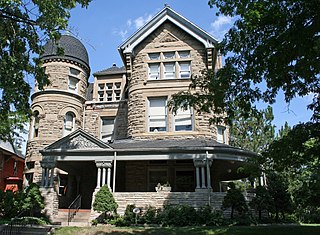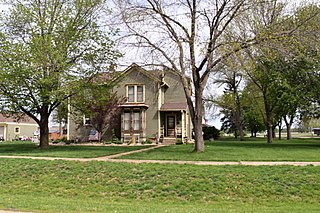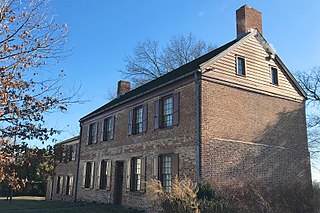
The William Cullen Bryant Homestead is the boyhood home and later summer residence of William Cullen Bryant (1794–1878), one of America's foremost poets and newspaper editors. The 155-acre (63 ha) estate is located at 205 Bryant Road in Cummington, Massachusetts, overlooks the Westfield River Valley and is currently operated by the non-profit Trustees of Reservations. It is open to the public on weekends in summer and early fall for tours with an admission fee.

This is intended to be a complete list of properties and districts listed on the National Register of Historic Places in Orleans County, New York. The locations of National Register properties and districts may be seen in a map by clicking on "Map of all coordinates". Two listings, the New York State Barge Canal and the Cobblestone Historic District, are further designated a National Historic Landmark.

Sugar Hill is a National Historic District in the Harlem and Hamilton Heights neighborhoods of Manhattan, New York City, bounded by West 155th Street to the north, West 145th Street to the south, Edgecombe Avenue to the east, and Amsterdam Avenue to the west. The equivalent New York City Historic Districts are:

The Dyckman House, now the Dyckman Farmhouse Museum, is the oldest remaining farmhouse on Manhattan island, a vestige of New York City's rural past. The Dutch Colonial-style farmhouse was built by William Dyckman, c.1785, and was originally part of over 250 acres (100 ha) of farmland owned by the family. It is now located in a small park at the corner of Broadway and 204th Street in Inwood, Manhattan.

Grace Bailey, also known for many years as Mattie, is a two-masted schooner whose home port is Camden Harbor, Camden, Maine. Built in 1882 in Patchogue, New York, she is one of four surviving two-masted wooden-hulled schooners, once the most common vessel in the American coasting trade. She was one of the first ships in the fleet of historic vessels known as "Maine windjammers", which offer cruises in Penobscot Bay and the Maine coast, entering that service in 1939. She last underwent major restoration in 1989–90. She was declared a National Historic Landmark in 1992.

Dominic Hall, also known as St. Dominic House and the William L. Bailey House, is a historic house on the Providence College campus in Providence, Rhode Island. It is a 2+1⁄2-story stone-faced structure with timber framing, and a prominent octagonal four-story tower at its southeastern corner. The house was built in the 1850s by William Bailey, who had a 23-acre (9.3 ha) estate. In the early 20th century the estate was acquired by the local Dominican Order, which used it as a convent and girls' school. The property was then absorbed by Providence College.

The Lewis Gouverneur and Nathalie Bailey Morris House is a historic building at 100 East 85th Street on the Upper East Side of Manhattan in New York City. The five-story dark red brick house was built in 1913-14 as a private residence for Lewis Gouverneur Morris, a financier and descendant of Gouverneur Morris, a signer of the Articles of Confederation and United States Constitution, and Alletta Nathalie Lorillard Bailey. In 1917, Morris & Pope is bankrupt but the family retains ownership of this house as well as their house in Newport, RI because his wife owned the property as collateral for a loan to him for his brokerage business. Alletta Nathalie Bailey Morris was a leading women's tennis player in the 1910s, winning the national indoor tennis championship in 1920.

The Architecture of Buffalo, New York, particularly the buildings constructed between the American Civil War and the Great Depression, is said to have created a new, distinctly American form of architecture and to have influenced design throughout the world.

The Bailey House was built in 1889, and was designed by William A. Lang. The Bailey House, built for a Mr. G.W. Bailey, is the largest of William Lang's surviving residential residences. William A. Lang (1846–1897) was a Denver architect who was active from 1885 to 1893.

The William E. Ward House, known locally as Ward's Castle, is located on Magnolia Drive, on the state line between Rye Brook, New York and Greenwich, Connecticut, United States. It is a reinforced concrete structure built in the 1870s.
The James William Beekman House is a historic house located on West Shore Road in Oyster Bay, Nassau County, New York.

The Bailey–Michelet House is a historic Italianate residence on Sheridan Road in Wilmette, Illinois. Originally built in Evanston, it was home to meatpacking businessman William Roberts Bailey and his wife Nancy. In 1896, the house was moved to Wilmette when it was sold to lawyer Charles Jules Michelet. Several generations of Michelet lived in the house. The building was listed on the National Register of Historic Places in 1982.

The General John Frelinghuysen House is a historic building located in Raritan, New Jersey. The older west wing was originally a tavern, built sometime before 1756 by Cornelius Bogert, when it also served as the town's meeting hall. It was bought in 1801 by John Frelinghuysen and then came to be known as the Frelinghuysen Homestead. It is an excellent example of early 19th century Federal architecture in New Jersey. In 1975, it was donated by Peter Frelinghuysen, Jr. to the borough and now serves as the Raritan Public Library.

Elm Farm, alsk known as the Sargent Farm, is a historic farm property at 599 Main Street in Danville, New Hampshire. Established about 1835, it has been in agricultural use since then, with many of its owners also engaged in small commercial or industrial pursuits on the side. The main farmhouse is one of the town's best examples of Gothic Revival architecture. The property was listed on the National Register of Historic Places in 1988.

The North Branch Historic District is a historic district located in North Branch, Somerset County, New Jersey. It is on the western side of the North Branch of the Raritan River in Branchburg Township. The district reflects the 18th and 19th century architecture of this agricultural community, once built around a mill on the North Branch. A main feature is the stone house of Jacob Ten Eyck, with its Georgian influences. The district was added to the National Register of Historic Places on April 16, 2012, for its significance in architecture and community development.

The George A. and Mary Tinkel Bailey House is a historic building located in Correctionville, Iowa, United States. Bailey was a native of Litchfield County, Connecticut, and he established the first bank in town after settling here in 1882. The name of the Sioux Valley State Bank was changed to the Bailey State Bank under a new charter in 1902. In addition to this house, Bailey was also responsible for the first brick commercial blocks in town. He built his house on the north side of town in an attempt to move the town out of the flood plain. William Jennings Bryan stayed in the home in 1911 while he was in town speaking at a Chautauqua. The two-story frame Queen Anne features elements from the Stick/Eastlake styles. The building was listed on the National Register of Historic Places in 1998.

The William H. and Alice Bailey House is an historic building located in Des Moines, Iowa. It is a two-story, balloon frame, front gable dwelling. Its significance is attributed to its association with the Baileys.

The Van Veghten House is a historic building in the Finderne section of Bridgewater Township, New Jersey. It was built around 1725 and served as the headquarters of Quartermaster General Nathanael Greene during the second Middlebrook encampment (1778–79) in the American Revolutionary War. The Somerset County Historical Society owns the house and uses it as its headquarters, including a museum and library. The early 18th-century Old York Road passed by here connecting Philadelphia to New York City. The house was added to the National Register of Historic Places on October 10, 1979 and noted as representing "one of the few remaining Raritan River mansions".
Beaver Street is a street in the Financial District of Lower Manhattan in New York City. Beaver Street runs five blocks from Pearl Street in the east to Broadway in the west. Along its length, it crosses Hanover, William, Broad, and New Streets. The street is preserved as part of the New Amsterdam street grid, a New York City designated landmark.





















